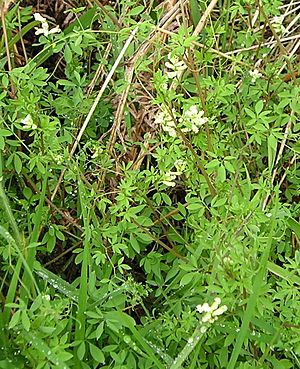Climbing corydalis facts for kids
Quick facts for kids Climbing corydalis |
|
|---|---|
 |
|
| Climbing corydalis | |
| Scientific classification | |
| Genus: |
Ceratocapnos
|
| Species: |
claviculata
|
| Synonyms | |
|
|
Ceratocapnos claviculata, also known as the climbing corydalis, is a delicate plant. It belongs to the Papaveraceae family, which also includes poppies. This plant is native to Europe, and you'll mostly find it growing near the Atlantic coast.
Contents
What Does Climbing Corydalis Look Like?
This plant looks delicate and doesn't have hairs. It usually lives for one year (an annual), but sometimes it can live longer (a perennial). It can grow up to a meter tall. It has weak, often pinkish, stems that climb.
The leaves are light to medium green. They are made of smaller parts, like tiny leaves. These leaves have stalks and are divided into even smaller sections. They end with a climbing tendril, which helps the plant grab onto things.
In the UK, climbing corydalis blooms (flowers) from June to September. The flowers are small, about 6 millimeters long. They are pale creamy-yellow and grow in short clusters near the stem. Each flower is long and shaped like a tube. They have a 'lip' and a 'spur' (a small pointy part). The pollen parts (stamens) are in two groups. The seed pods are short and often squeeze in between the two seeds inside.
How Did It Get Its Name?
Magnus Lidén officially named this plant Ceratocapnos claviculata in 1984. He published its description in a scientific journal called 'Anales Jard. Bot. Madrid'. He based this on an earlier description by Carl Linnaeus, who had called it Fumaria claviculata.
The second part of its scientific name, claviculata, is Latin. It means 'having tendrils' or 'being tendrilled'. This describes how the plant climbs using its tendrils.
Where Does Climbing Corydalis Grow?
This plant is found in several countries in western Europe. These include Belgium, Denmark, France, Germany, Ireland, Netherlands, Spain, Portugal, and Norway. Most of the world's climbing corydalis plants live in the United Kingdom.
It grows in most parts of Britain, especially in the west. However, it's not found in Orkney, Shetland, or the Outer Hebrides. It's also rare in Ireland. As of 2005, experts say it's not a threatened plant in the UK.
Where Does It Live and What Does It Eat?
Climbing corydalis often grows at the edges of woodlands or in places that used to be wooded. It likes acidic soils, like sandy or peaty ground. It usually prefers sheltered spots with some shade. You might find a lot of it in disturbed areas of recently cleared forests or woods, climbing over wood debris. It can grow well in poor soil under bracken ferns. This might be because it flowers early in the year before the fern fronds fully grow.
This plant is a food source for certain insects. These include the weevil, Procas granulicollis, and the beetle, Sirocalodes mixtus.
Honey bees and bumblebees help to pollinate this plant. This means they carry pollen from one flower to another, helping the plant make seeds.
 In Spanish: Ceratocapnos claviculata para niños
In Spanish: Ceratocapnos claviculata para niños

